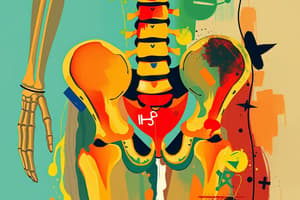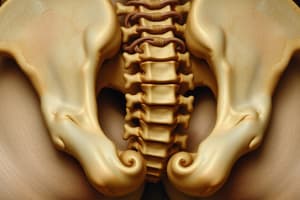Podcast
Questions and Answers
What is the most common mechanism of injury (MOI) leading to spinal cord injuries?
What is the most common mechanism of injury (MOI) leading to spinal cord injuries?
- Sports injuries
- Falls
- Violence
- Motor vehicle collisions (correct)
Which vertebrae are the most frequently injured?
Which vertebrae are the most frequently injured?
- Cervical vertebrae (correct)
- Sacral vertebrae
- Lumbar vertebrae
- Thoracic vertebrae
What can localized edema cause?
What can localized edema cause?
- Airway obstruction (correct)
- Deep venous thrombosis
- Pulmonary emboli
- Decubitus ulcers
What is the function of the anterior (ventral) horn in the spinal cord?
What is the function of the anterior (ventral) horn in the spinal cord?
What is a common complication of spinal cord injuries due to decreased mobility?
What is a common complication of spinal cord injuries due to decreased mobility?
How many pairs of spinal nerves are there?
How many pairs of spinal nerves are there?
What is the goal of administering Methylprednisolone (MP) within 8 hours of injury?
What is the goal of administering Methylprednisolone (MP) within 8 hours of injury?
What is the purpose of applying cervical tongs or halo devices in unstable cervical fractures?
What is the purpose of applying cervical tongs or halo devices in unstable cervical fractures?
What is the purpose of spinal protection in patient assessment?
What is the purpose of spinal protection in patient assessment?
What occurs in complete spinal cord transections?
What occurs in complete spinal cord transections?
What is the recommended method of immobilizing the spine?
What is the recommended method of immobilizing the spine?
What is the definition of spinal shock?
What is the definition of spinal shock?
What is a common mechanism of injury (MOI) associated with cervical spine injuries?
What is a common mechanism of injury (MOI) associated with cervical spine injuries?
Why is early endotracheal intubation considered in patients with injuries at the C5 level or above?
Why is early endotracheal intubation considered in patients with injuries at the C5 level or above?
When should spinal injuries be suspected?
When should spinal injuries be suspected?
What is a risk factor for pulmonary emboli in spinal cord injury patients?
What is a risk factor for pulmonary emboli in spinal cord injury patients?
What is a sign of a potential spinal cord injury?
What is a sign of a potential spinal cord injury?
What is a visible sign of spinal injury during inspection?
What is a visible sign of spinal injury during inspection?
What is the effect of injuries to the cord between C3 and C5?
What is the effect of injuries to the cord between C3 and C5?
What is an indication of a cervical spine injury?
What is an indication of a cervical spine injury?
What is a characteristic of a patient with a spinal cord injury?
What is a characteristic of a patient with a spinal cord injury?
What is a characteristic of neurogenic shock?
What is a characteristic of neurogenic shock?
What is the purpose of radiographic evaluation in patients with spinal trauma?
What is the purpose of radiographic evaluation in patients with spinal trauma?
What is a risk for patients with cervical spine trauma during airway management?
What is a risk for patients with cervical spine trauma during airway management?
What is a characteristic of spinal and neurogenic shock?
What is a characteristic of spinal and neurogenic shock?
What is a symptom of an incomplete spinal cord injury?
What is a symptom of an incomplete spinal cord injury?
What is central cord syndrome caused by?
What is central cord syndrome caused by?
In anterior cord syndrome, which sensations are preserved?
In anterior cord syndrome, which sensations are preserved?
What is a characteristic of posterior cord syndrome?
What is a characteristic of posterior cord syndrome?
In Brown-Séquard syndrome, which sensations are affected contralaterally?
In Brown-Séquard syndrome, which sensations are affected contralaterally?
What is a type of nerve root injury?
What is a type of nerve root injury?
What is a common cause of nerve root injuries?
What is a common cause of nerve root injuries?
Study Notes
Cervical Spine Injuries
- Localized edema can cause airway obstruction, and endotracheal intubation should be considered early in patients with injuries at the C5 level or above.
- Cervical spine protection equipment includes a rigid cervical collar, lateral head immobilizer, and full backboard with straps.
Circulation Management
- Patients may experience hypotension due to neurogenic or hypovolemic shock.
- Injuries at T6 or above can cause loss of sympathetic tone, leading to hypotension and bradycardia.
Pharmacologic Management
- Methylprednisolone (MP) may be administered within 8 hours of injury to reduce edema, ischemia, and prevent cellular death.
Cervical Tongs and Skeletal Fixation
- Unstable cervical fractures may be stabilized in the ED with application of cervical tongs or halo devices to provide consistent traction and minimize cord compression.
Spinal Cord Injuries
- Injuries of the vertebral column may occur with or without associated spinal cord injury.
- Spinal cord transections may be complete or incomplete, with complete transections leading to loss of all motor and sensory function below the level of the injury.
- Incomplete spinal cord transections result in partial preservation of some motor and/or sensory tracts.
- Patients with spinal cord injuries are at risk for deep venous thrombosis, decubitus ulcers, and pulmonary emboli.
Spinal and Neurogenic Shock
- Spinal shock is the loss of reflexes and motor and sensory function below the level of the injury.
- Neurogenic shock is characterized by hypotension and bradycardia, usually seen with injuries above the T6 level.
Anatomy and Physiology
- The vertebral column consists of 7 cervical vertebrae, 12 thoracic vertebrae, 5 lumbar vertebrae, 5 sacral vertebrae, and 1 coccygeal vertebrae.
- The cervical vertebrae are the most frequently injured due to their high mobility and delicate structure.
- The spinal cord consists of the posterior (dorsal) horn for sensory function, lateral horn for autonomic function, and anterior (ventral) horn for motor function.
- There are 31 pairs of spinal nerves, including 8 cervical nerves, 12 thoracic nerves, 5 lumbar nerves, 5 sacral nerves, and 1 coccygeal nerve.
Patient Assessment
- All patients with multisystem injuries or significant mechanisms of injury should be suspected of having a spinal injury and should be completely immobilized.
- Spinal protection involves manual immobilization with hands, cervical collar, lateral head support, and backboard with straps.
- The entire spine should be immobilized using a backboard with straps across the chest, abdomen, and knees.
Mechanism of Injury
- Common mechanisms of injury associated with cervical spine injuries include falls from a height greater than or equal to 3 feet or five stairs, axial loading, motor vehicle collisions at a high rate of speed with rollover or ejection, and bicycle collisions.
- Suspicion of spinal injury should be raised if the patient has a fall resulting in fractures of the heels or an unrestrained patient presents with facial injuries.
History and Inspection
- Pieces of history that may indicate a potential spinal cord injury include significant trauma, altered mental status, seizure activity, complaint of neck pain or altered sensation, neck tenderness, loss of consciousness, and incontinence.
- Obvious signs of spinal injury include deformity of the vertebral column, cervical edema, ballistic wounds, and abrasions or contusions at the level of the lap or shoulder belt.
Reflex Testing
- Biceps reflex tests C5-C6, and anal wink reflex tests S2-S4.
Radiographic Evaluation
- Cervical spine and all seven cervical vertebrae, including the C7-T1 junction, should be evaluated.
- Patients with a history of a fall or significant chest and abdominal trauma should have thoracic and lumbosacral spine films.
- Patients with an altered mental status require complete spinal radiographic evaluation.
Airway Management
- Patients with cervical spine trauma are at risk for hypoxia, respiratory arrest, and aspiration.
Incomplete Spinal Cord Injuries
- Types of incomplete spinal cord injuries include central cord syndrome, anterior cord syndrome, posterior cord syndrome, Brown-Séquard syndrome, and nerve root injuries.
- Characteristics include asymmetric reflexes, flaccid paralysis, and some preserved sensations below the level of the injury.
- Central cord syndrome causes greater loss of function in the upper extremities than in the lower extremities, and bowel and bladder function are typically maintained.
- Anterior cord syndrome results in loss of motor function and pain and temperature sensations below the level of the injury.
- Posterior cord syndrome is rare and results in impaired light touch and proprioception.
- Brown-Séquard syndrome results in ipsilateral paresis or hemiplegia and loss of motor function, touch, pressure, vibratory sense, and proprioception, and contralateral loss or decreased sensation of pain and temperature.
- Nerve root injuries include conus medullaris and cauda equina syndromes, resulting from nerve root compression.
Studying That Suits You
Use AI to generate personalized quizzes and flashcards to suit your learning preferences.
Description
This quiz covers the importance of early endotracheal intubation, cervical spine protection, and circulation management in trauma patients with spinal injuries. Topics include equipment usage, shock management, and sympathetic tone.




